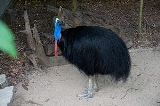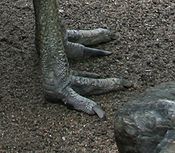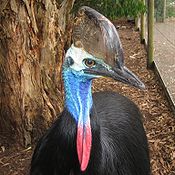
Southern Cassowary
Encyclopedia
The Southern Cassowary, Casuarius casuarius, also known as Double-wattled Cassowary, Australian Cassowary or Two-wattled Cassowary, is a large flightless black bird. It is a ratite
and therefore related to the Emu
, Ostrich
, and the genus Rhea
.
 It has hard and stiff plumage, a brown casque, blue face and neck, red nape and two red wattles hanging down its throat. The three-toed feet are thick and powerful, equipped with a lethal dagger-like claw up to 12 cm (4.7 in) on the inner toe. The plumage is sexually monomorphic, but the female is dominant and larger with a longer casque and brighter-colored bare parts. The juveniles have brown longitudinal striped plumage. It is the largest member of the cassowary
It has hard and stiff plumage, a brown casque, blue face and neck, red nape and two red wattles hanging down its throat. The three-toed feet are thick and powerful, equipped with a lethal dagger-like claw up to 12 cm (4.7 in) on the inner toe. The plumage is sexually monomorphic, but the female is dominant and larger with a longer casque and brighter-colored bare parts. The juveniles have brown longitudinal striped plumage. It is the largest member of the cassowary
family and is the second heaviest bird on earth, at a maximum size estimated at 85 kilograms (187.4 lb) and 190 centimetres (74.8 in). Normally this species ranges from 127 to 170 cm (50 to 66.9 in), with females averaging 58 kilograms (127.9 lb) and males averaging 29 to 34 kg (63.9 to 75 lb). It is technically the largest Asia
n bird (since the extinction of the Arabian Ostrich
, and previously the Moa
of New Zealand
) and the largest Australian bird (though the Emu
may be slightly taller).
, New Guinea
and northeastern Australia
, and it prefers elevations below 1100 m (3,608.9 ft) in Australia
, and 500 m (1,640.4 ft) on New Guinea
.
They make a booming call during mating season and hissing and rumblings otherwise. Chicks will make frequent high-pitches whistles to call the male.
The blade-like claws are capable of killing humans and dogs if the bird is provoked.
on the IUCN Red List
of Threatened Species. The Australian population is listed as Endangered
under Federal and Queensland State legislation. Some threats are through habitat loss (logging), feral animals eating their eggs, hunting, and roadkill. Road building, feral animals and hunting are the worst of these threats. It has an occurrence range of 396000 km² (152,896.5 sq mi), and between 10,000 and 20,000 birds were estimated in a 2002 study, with between 1,500 and 2,500 in Australia.
 Presently, most authorities consider the Southern Cassowary monotypic
Presently, most authorities consider the Southern Cassowary monotypic
, but several subspecies
have been described. It has proven very difficult to confirm the validity of these due to individual variations, age-related variations, the relatively few available specimen
s (and the bright skin of the head and neck – the basis of which several subspecies have been described – fades in specimens), and that locals are known to have traded live cassowaries for hundreds, if not thousands, of years, some of which are likely to have escaped/been deliberately introduced
to regions away from their origin.
Cassowaries, of the family Casuariidae, are closely related to the kiwi
s in the family Apterygidae, with these two bird families diverging from a common ancestor 40 million years ago. The Southern Cassowary is in the class Aves, which includes all birds; those that can fly as well as those that cannot.
Their binomial name Casuarius casuarius is derived from the Malay
word kesuari, meaning cassowary. The Southern Cassowary was first described by Carolus Linnaeus
in his 18th century work, Systema Naturae
, as Struthio casuarius, from a specimen from Seram
, in 1758. It is now the type species
of the genus Casuarius.
Ratite
A ratite is any of a diverse group of large, flightless birds of Gondwanan origin, most of them now extinct. Unlike other flightless birds, the ratites have no keel on their sternum—hence the name from the Latin ratis...
and therefore related to the Emu
Emu
The Emu Dromaius novaehollandiae) is the largest bird native to Australia and the only extant member of the genus Dromaius. It is the second-largest extant bird in the world by height, after its ratite relative, the ostrich. There are three subspecies of Emus in Australia...
, Ostrich
Ostrich
The Ostrich is one or two species of large flightless birds native to Africa, the only living member of the genus Struthio. Some analyses indicate that the Somali Ostrich may be better considered a full species apart from the Common Ostrich, but most taxonomists consider it to be a...
, and the genus Rhea
Rhea (bird)
The rheas are ratites in the genus Rhea, native to South America. There are two existing species: the Greater or American Rhea and the Lesser or Darwin's Rhea. The genus name was given in 1752 by Paul Möhring and adopted as the English common name. Möhring's reason for choosing this name, from the...
.
Description

Cassowary
The cassowaries are ratites, very large flightless birds in the genus Casuarius native to the tropical forests of New Guinea, nearby islands and northeastern Australia. There are three extant species recognized today...
family and is the second heaviest bird on earth, at a maximum size estimated at 85 kilograms (187.4 lb) and 190 centimetres (74.8 in). Normally this species ranges from 127 to 170 cm (50 to 66.9 in), with females averaging 58 kilograms (127.9 lb) and males averaging 29 to 34 kg (63.9 to 75 lb). It is technically the largest Asia
Asia
Asia is the world's largest and most populous continent, located primarily in the eastern and northern hemispheres. It covers 8.7% of the Earth's total surface area and with approximately 3.879 billion people, it hosts 60% of the world's current human population...
n bird (since the extinction of the Arabian Ostrich
Arabian Ostrich
The Middle Eastern Ostrich or Arabian Ostrich is an extinct subspecies of the ostrich which once lived on the Arabian Peninsula and in the Near East. Its range seems to have been continuous in prehistoric times, but with the drying-up of the Arabian Peninsula, it disappeared from the inhospitable...
, and previously the Moa
Moa
The moa were eleven species of flightless birds endemic to New Zealand. The two largest species, Dinornis robustus and Dinornis novaezelandiae, reached about in height with neck outstretched, and weighed about ....
of New Zealand
New Zealand
New Zealand is an island country in the south-western Pacific Ocean comprising two main landmasses and numerous smaller islands. The country is situated some east of Australia across the Tasman Sea, and roughly south of the Pacific island nations of New Caledonia, Fiji, and Tonga...
) and the largest Australian bird (though the Emu
Emu
The Emu Dromaius novaehollandiae) is the largest bird native to Australia and the only extant member of the genus Dromaius. It is the second-largest extant bird in the world by height, after its ratite relative, the ostrich. There are three subspecies of Emus in Australia...
may be slightly taller).
Range and habitat
The Southern Cassowary is distributed in tropical rainforests of IndonesiaIndonesia
Indonesia , officially the Republic of Indonesia , is a country in Southeast Asia and Oceania. Indonesia is an archipelago comprising approximately 13,000 islands. It has 33 provinces with over 238 million people, and is the world's fourth most populous country. Indonesia is a republic, with an...
, New Guinea
New Guinea
New Guinea is the world's second largest island, after Greenland, covering a land area of 786,000 km2. Located in the southwest Pacific Ocean, it lies geographically to the east of the Malay Archipelago, with which it is sometimes included as part of a greater Indo-Australian Archipelago...
and northeastern Australia
Australia
Australia , officially the Commonwealth of Australia, is a country in the Southern Hemisphere comprising the mainland of the Australian continent, the island of Tasmania, and numerous smaller islands in the Indian and Pacific Oceans. It is the world's sixth-largest country by total area...
, and it prefers elevations below 1100 m (3,608.9 ft) in Australia
Australia
Australia , officially the Commonwealth of Australia, is a country in the Southern Hemisphere comprising the mainland of the Australian continent, the island of Tasmania, and numerous smaller islands in the Indian and Pacific Oceans. It is the world's sixth-largest country by total area...
, and 500 m (1,640.4 ft) on New Guinea
New Guinea
New Guinea is the world's second largest island, after Greenland, covering a land area of 786,000 km2. Located in the southwest Pacific Ocean, it lies geographically to the east of the Malay Archipelago, with which it is sometimes included as part of a greater Indo-Australian Archipelago...
.
| Location | Population | Trend |
|---|---|---|
| Southern Papua New Guinea Papua New Guinea Papua New Guinea , officially the Independent State of Papua New Guinea, is a country in Oceania, occupying the eastern half of the island of New Guinea and numerous offshore islands... |
unknown | Declining |
| Seram Seram Seram is an island in the Maluku province of Indonesia. It is located north of Ambon Island. The chief port/town is Masohi.- Geography and geology :... |
Unknown | Unknown |
| Aru Islands Aru Islands The Aru Islands are a group of about ninety-five low-lying islands in the Maluku province of eastern Indonesia. They also form a regency of Indonesia.-Geography:... |
Unknown | Unknown |
| Northeastern Australia Australia Australia , officially the Commonwealth of Australia, is a country in the Southern Hemisphere comprising the mainland of the Australian continent, the island of Tasmania, and numerous smaller islands in the Indian and Pacific Oceans. It is the world's sixth-largest country by total area... |
1,500 to 2,500 | Declining |
| **Paluma Range Paluma Range National Park Paluma Range is a national park located between Ingham and Townsville, in north Queensland, Australia. The park is 1188 km north of Brisbane. The park contains the Jourama Falls, Crystal Creek and Lake Paluma... |
Unknown | Declining |
| **McIlwraith Range McIlwraith Range The McIlwraith Range is a rugged, dissected granite plateau on the Cape York Peninsula, Far North Queensland, Australia. Part of the Great Dividing Range, it covers about 3000 km2 and lies about 15 km east of the town of Coen, and 550 km north of Cairns... |
1000+ | Declining |
| **Jardine River National Park Jardine River National Park The Jardine River National Park is a national park Queensland, Australia, 2137 km northwest of Brisbane and about 900 km northwest of Cairns, on the tip of Cape York Peninsula.... |
Unknown | Unknown |
| Total | 2,500+ | Declining |
Behaviour
It forages on the forest floor for fallen fruit and is capable of safely digesting some fruits toxic to other animals. They also eat fungi, and some insects and small vertebrates. The Southern Cassowary is a solitary bird, that pairs only in breeding season, which takes place in late winter or spring. The male builds a nest on the ground; a mattress of herbaceous plant material 5 to 10 cm (2 to 3.9 in) thick and up to 100 centimetres (39.4 in) wide. This is thick enough to let moisture drain away from the eggs. The male also incubates the eggs and raises the chicks alone. A clutch of three or four eggs are laid measuring 138 by 95 mm (5.4 by 3.7 in). They have a granulated surface and are initially bright pea-green in colour although they fade with age.They make a booming call during mating season and hissing and rumblings otherwise. Chicks will make frequent high-pitches whistles to call the male.
The blade-like claws are capable of killing humans and dogs if the bird is provoked.
Conservation
Due to ongoing habitat loss, limited range and overhunting in some areas, the Southern Cassowary is evaluated as VulnerableVulnerable species
On 30 January 2010, the IUCN Red List of Threatened Species identified 9694 Vulnerable species, subspecies and varieties, stocks and sub-populations.-References:...
on the IUCN Red List
IUCN Red List
The IUCN Red List of Threatened Species , founded in 1963, is the world's most comprehensive inventory of the global conservation status of biological species. The International Union for Conservation of Nature is the world's main authority on the conservation status of species...
of Threatened Species. The Australian population is listed as Endangered
Endangered species
An endangered species is a population of organisms which is at risk of becoming extinct because it is either few in numbers, or threatened by changing environmental or predation parameters...
under Federal and Queensland State legislation. Some threats are through habitat loss (logging), feral animals eating their eggs, hunting, and roadkill. Road building, feral animals and hunting are the worst of these threats. It has an occurrence range of 396000 km² (152,896.5 sq mi), and between 10,000 and 20,000 birds were estimated in a 2002 study, with between 1,500 and 2,500 in Australia.
Taxonomy

Monotypic
In biology, a monotypic taxon is a taxonomic group with only one biological type. The term's usage differs slightly between botany and zoology. The term monotypic has a separate use in conservation biology, monotypic habitat, regarding species habitat conversion eliminating biodiversity and...
, but several subspecies
Subspecies
Subspecies in biological classification, is either a taxonomic rank subordinate to species, ora taxonomic unit in that rank . A subspecies cannot be recognized in isolation: a species will either be recognized as having no subspecies at all or two or more, never just one...
have been described. It has proven very difficult to confirm the validity of these due to individual variations, age-related variations, the relatively few available specimen
Specimen
A specimen is a portion/quantity of material for use in testing, examination, or study.BiologyA laboratory specimen is an individual animal, part of an animal, a plant, part of a plant, or a microorganism, used as a representative to study the properties of the whole population of that species or...
s (and the bright skin of the head and neck – the basis of which several subspecies have been described – fades in specimens), and that locals are known to have traded live cassowaries for hundreds, if not thousands, of years, some of which are likely to have escaped/been deliberately introduced
Introduced species
An introduced species — or neozoon, alien, exotic, non-indigenous, or non-native species, or simply an introduction, is a species living outside its indigenous or native distributional range, and has arrived in an ecosystem or plant community by human activity, either deliberate or accidental...
to regions away from their origin.
Cassowaries, of the family Casuariidae, are closely related to the kiwi
Kiwi
Kiwi are flightless birds endemic to New Zealand, in the genus Apteryx and family Apterygidae.At around the size of a domestic chicken, kiwi are by far the smallest living ratites and lay the largest egg in relation to their body size of any species of bird in the world...
s in the family Apterygidae, with these two bird families diverging from a common ancestor 40 million years ago. The Southern Cassowary is in the class Aves, which includes all birds; those that can fly as well as those that cannot.
Their binomial name Casuarius casuarius is derived from the Malay
Malay language
Malay is a major language of the Austronesian family. It is the official language of Malaysia , Indonesia , Brunei and Singapore...
word kesuari, meaning cassowary. The Southern Cassowary was first described by Carolus Linnaeus
Carolus Linnaeus
Carl Linnaeus , also known after his ennoblement as , was a Swedish botanist, physician, and zoologist, who laid the foundations for the modern scheme of binomial nomenclature. He is known as the father of modern taxonomy, and is also considered one of the fathers of modern ecology...
in his 18th century work, Systema Naturae
Systema Naturae
The book was one of the major works of the Swedish botanist, zoologist and physician Carolus Linnaeus. The first edition was published in 1735...
, as Struthio casuarius, from a specimen from Seram
Seram
Seram is an island in the Maluku province of Indonesia. It is located north of Ambon Island. The chief port/town is Masohi.- Geography and geology :...
, in 1758. It is now the type species
Type species
In biological nomenclature, a type species is both a concept and a practical system which is used in the classification and nomenclature of animals and plants. The value of a "type species" lies in the fact that it makes clear what is meant by a particular genus name. A type species is the species...
of the genus Casuarius.
External links
- ARKive - images and movies of the Southern Cassowary (Casuarius casuarius)
- BirdLife Species Factsheet
- IUCN Red List
- Red Data Book
- Southern Cassowary videos on the Internet Bird Collection
- The Cassowary (text and images)

